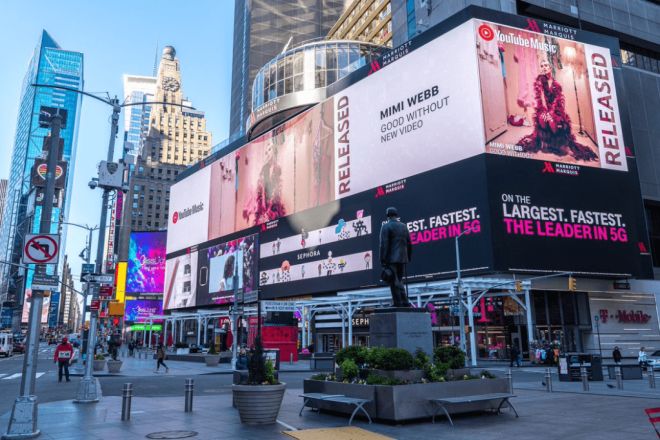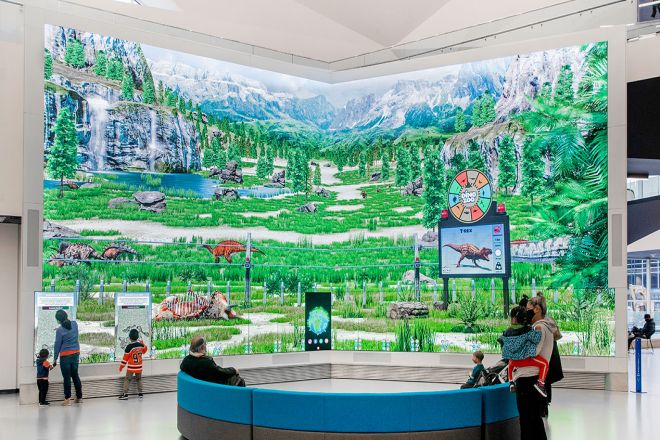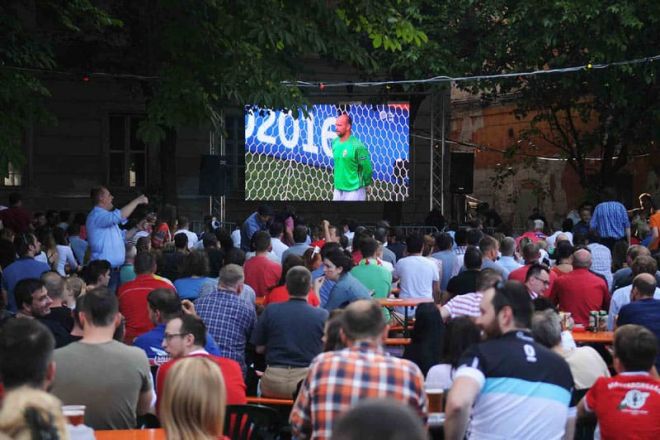Introduction

Dans la vague de l’ère numérique, LED display advertising, as an emerging media form, has gradually become a dark horse in the field of advertising communication with its unique advantages and wide range of application scenarios.
With the continuous development of technology and the increasing maturity of the market, LED display advertising is no longer a simple visual display tool but has evolved into a powerful medium that can span multiple media platforms and achieve all-round and multi-angle communication.
1. Analysis of the advantages of LED display advertising
1). Avantages techniques
LED displays have shown significant technical advantages in the advertising field. These advantages not only improve the display effect of advertising but also meet the diverse needs of the modern advertising market.
Haute luminosité: The high brightness characteristics of the LED display enable it to maintain a clear display effect under various light conditions. Whether it is under direct sunlight outdoors or in a dark indoor environment, LED displays can ensure the clarity and readability of advertisements and effectively attract the audience’s attention.
Couleurs riches : LED display supports a variety of colors and dynamic effects, which makes advertising content richer and more diverse. Through vivid colors and dynamic effects, LED displays can enhance the attractiveness and visual impact of advertisements, allowing advertising information to be conveyed to the audience more intuitively.
Haute définition: The LED display screen has the characteristics of high resolution and high definition, which can present delicate picture quality and clear images. This makes the advertising content more vivid and lifelike when displayed, giving the audience a better visual experience.
Faible consommation d’énergie : LED display screens perform excellently in terms of energy consumption. Compared with traditional display devices, they consume less energy and are more energy-saving and environmentally friendly. This is in line with the concept of sustainable development in modern society and also reduces operating costs for enterprises.
Forte personnalisation : LED display screens are highly customizable and can be personalized according to different scenarios and needs. No matter the shape, size, or display content, they can be flexibly adjusted according to actual needs to meet various advertising display needs.
2). Wide range of application scenarios
The application scenarios of LED displays are very wide, covering almost all areas that require advertising displays.
Promotion commerciale : In the commercial field, LED displays are widely used in in-store advertising, billboards, large screens in shopping mall centers, and other scenarios. Displaying brand image, promotional activities, and other information through LED displays can attract customers’ attention and increase brand awareness and sales.
Entertainment industry: In the entertainment industry, LED displays also play an important role. Whether it is stage performances, sports events, cinema screenings, amusement parks, and other scenes, LED displays can provide a clear and vivid visual experience, enhancing the audience’s sense of participation and immersion.
Other fields: In addition, LED displays are also widely used in other fields such as conference displays, urban lighting, and traffic instructions. In conference presentations, LED displays can clearly display conference content; in city lighting, LED displays can beautify the city’s night scene; in traffic instructions, LED displays can display traffic information in real-time and guide vehicles and pedestrians to pass safely.
2. Cross-media strategy for LED display advertising

1). Cross-media integration
The first task of the cross-media strategy of LED display advertising is to achieve integration with traditional media and new media to form an advertising synergy and maximize the communication effect.
- Linkage with traditional media:
LED display advertising can be linked with traditional media such as television, newspapers, and radio. For example, when a certain brand or event is mentioned in a TV program, relevant advertisements can be displayed on the LED display at the same time, creating a double impact of visual and auditory effects and increasing brand exposure.
- Utilize the Internet and social media:
Through the Internet and social media platforms, LED display advertising can broaden communication channels and cover a wider audience. For example, the advertising function of social media platforms can be used to push LED display advertisements to target user groups to improve the accuracy and interactivity of advertisements.
- Integrate online and offline resources:
LED display advertising can not only be used as a tool for offline display but can also be combined with online activities to form a comprehensive advertising communication network. For example, displaying QR codes or links for online activities on LED displays in shopping malls or stores can guide consumers to participate in online interactions and increase user participation and brand loyalty.
2). Accurate positioning and personalized push
Using modern technology, LED display advertising can achieve precise positioning and personalized push, improving advertising effectiveness.
- Analyse des mégadonnées :
Through the analysis of big data, we can gain an in-depth understanding of the interests, needs, and behavioral habits of the target audience, so as to accurately locate the target audience. On this basis, LED display advertising can display different advertising content according to the characteristics and needs of different audiences to achieve personalized push.
- Artificial intelligence and machine learning:
Using artificial intelligence and machine learning technology, advertising push strategies can be continuously optimized. By monitoring advertising effects and user feedback in real-time, the system can automatically adjust parameters such as advertising content, display methods, and delivery time to improve advertising click-through rates, conversion rates, and user satisfaction.
3). Interactive experience and branding
The innovative form and interactive experience of LED display advertising can enhance the audience’s participation and favorability, thereby enhancing brand image and value.
- Formes publicitaires innovantes :
LED display advertising can adopt a variety of innovative forms, such as AR/VR technology, touch screen interaction, etc., to bring a new visual and interactive experience to the audience. These innovative forms can attract the audience’s attention and improve the memorability and dissemination of advertisements.
- Branding:
Combining corporate culture and brand image, LED display advertising can create a unique advertising style. Through consistent visual elements, language style, and brand tone, brand recognition and awareness can be strengthened, and brand value and influence can be enhanced. At the same time, brand image and loyalty can be further consolidated through in-depth interaction and emotional connection with the target audience.
3. Difficulties and challenges of LED display advertising cross-media strategy
The difficulties and challenges of LED display advertising cross-media strategy are mainly reflected in the following aspects:
- Technology integration and innovation challenges:
The cross-media strategy of LED display advertising requires the integration of technologies and resources from different media platforms to ensure the seamless connection and efficient dissemination of advertising content on different platforms.
This requires the advertising production team to have cross-platform technology integration capabilities and be able to deal with various technical challenges.
With the continuous upgrading of technology, LED display advertising needs to keep up with the technological trend and continue to carry out technological innovation. However, technological innovation not only requires a large investment in research and development costs but also requires a professional technical team and innovation capabilities.
- Data collection and analysis challenges:
Achieving precise positioning and personalized push requires collecting and analyzing large amounts of user data. However, the data collection process may face issues of user privacy protection and data security, which need to be carried out in compliance with relevant laws and regulations.
At the same time, the accuracy and validity of data analysis are also a challenge. Advanced data analysis technologies and algorithms are required to conduct in-depth mining and analysis of user data in order to draw accurate conclusions and effective marketing strategies.
- Cross-platform coordination and management challenges:
The cross-media strategy of LED display advertising involves multiple media platforms, which requires the coordination and management of advertising content, playback time, and placement strategies on each platform.
This requires the advertising team to have cross-platform coordination capabilities to ensure the unity and coherence of advertising on different platforms.
At the same time, due to differences in operating models and standards between different media platforms, a large amount of communication and negotiation is required to reach a consensus and successfully implement cross-media strategies.
- Market competition and cost control challenges:
The LED display advertising market is highly competitive, and it is necessary to continuously innovate and optimize advertising content and services in order to attract more users and improve advertising effectiveness. However, this will also bring about the problem of rising costs, and costs need to be controlled while ensuring advertising effectiveness.
In addition, as market competition intensifies, advertising prices may also increase, further increasing advertising costs. Therefore, effective cost-control strategies need to be developed to ensure the sustainable development of advertising cross-media strategies.
- User experience and branding challenges:
LED display advertising cross-media strategy needs to focus on user experience and brand building. However, in the process of cross-media communication, ensuring the coherence and consistency of advertising content and improving user experience and favorability are all challenges that need to be faced.
At the same time, brand image building also needs to consider the characteristics of different media platforms and differences in audience groups and formulate advertising strategies that meet the brand’s tone and the needs of the target audience.
4. Future prospects of LED display advertising cross-media strategy

1). Technological innovation trends
With the continuous development of science and technology, LED display technology will also usher in a series of innovative trends in the field of advertising and communication.
- Higher brightness and richer colors:
The brightness of LED displays will be further improved to ensure excellent display effects under various light conditions. At the same time, the color performance will be richer and more vivid, providing a more vivid and realistic display effect for advertising content.
- Smarter interaction:
In the future, LED displays will pay more attention to the interactive experience with the audience. Through touch screen technology, sensor technology, voice recognition technology, and other means, the audience will be able to interact with the LED display screen more intuitively and intelligently, such as sliding the screen, using gesture control, using voice commands, etc.
This will provide a richer and more diverse display format for advertising content while increasing audience engagement and favorability.
- Flexibilité et personnalisation :
With the continuous development of flexible LED technology, future LED displays will have higher customizability and flexibility. Display products of various shapes and sizes can be produced to meet personalized customization for different scenarios and needs. This will provide more diverse display methods for advertising content while reducing production costs and installation difficulty.
2). Market development trends
The LED display advertising market will continue to maintain a rapid development trend in the future.
- Expansion of application scenarios:
In the future, the application scenarios of LED display advertising will be further expanded. In addition to traditional commercial promotion, entertainment industry, and other fields, it will also be used in emerging fields such as smart cities, intelligent transportation, and environmental monitoring. This will provide a broader market space and development opportunities for the LED display advertising market.
3). Deepening and Expanding Cross-Media Strategy
With the continuous advancement of technology and the changing market, the cross-media strategy of LED display advertising will be further deepened and expanded in the future.
- Strengthening of cross-media integration:
In the future, LED display advertising will pay more attention to integration and linkage with other media forms. Through deep integration with traditional media such as television, newspapers, and radio, as well as new media such as the Internet and social media, the rapid dissemination and extensive coverage of advertising information can be achieved.
- Improvement of precise positioning and personalized push:
With the help of advanced technologies such as big data and artificial intelligence, LED display advertising will achieve more precise positioning and personalized push. Through in-depth analysis and mining of target audiences, we provide customized advertising content and services for different user groups to improve advertising conversion rates and user satisfaction.
- Innovation in interactive experience and branding:
In the future, LED display advertising will pay more attention to innovation in interactive experience and branding. Enhance brand awareness and favorability through innovative advertising formats and enhanced audience participation and experience. At the same time, we combine corporate culture and brand image to create a unique advertising style and tone to enhance brand value and influence.
Conclusion
Through an in-depth discussion of the cross-media strategy of LED display advertising, it is not difficult to find that the successful implementation of this strategy is inseparable from technological innovation, precise positioning, interactive experience, and other aspects of efforts.
With the continuous advancement of technology and the continuous changes in the market, the application of cross-media strategy in LED display advertising will be more extensive, the forms will be more diverse, and the effect will be more significant.
Enfin, si vous souhaitez en savoir plus sur les écrans LED, veuillez nous contacter.
